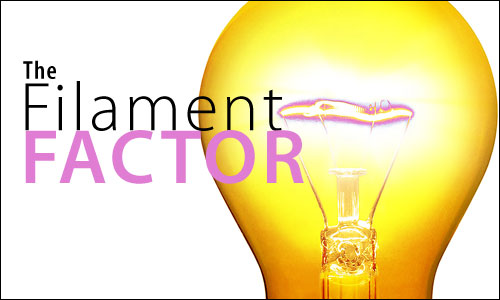
“Think outside the box.”
“Can we afford this?”
“We hired you for your ideas.”
“We don’t have enough people or time to work on this.”
“Don’t follow the rest of the pack.”
“That’s not what our competitors are doing.”
“Be innovative.”
“I’m not going to be responsible if this fails.”
It’s not uncommon to hear the phrases above in most organizations today. The confusing part is that you could probably hear conflicting versions in the same group, maybe even from the same person about the same project. There are innumerable business articles written about the importance of creativity and innovation within companies today. At the same time, more and more time and effort is spent on Lean Management initiatives and Six Sigma certifications. We talk about better ideas, but act on improving efficiency.
Thomas Edison experimented with over 6,000 vegetable fibers (or 1,600 according to another source) searching for a filament to illuminate light bulbs. He filled over 40,000 pages with notes before having a successfully tested bulb. That is not necessarily a model of efficiency. Most organizations today don’t have the tolerance for a single failure, let alone 1,599 (or 5,999).
Edison is not the only example of tolerating failure in search of success. Edison is quoted as saying, “Every wrong attempt discarded is a step forward.” Yet businesses today give seemingly bipolar messaging around failure. Business leaders are not ignorant of the need for creativity and innovation, they simply understand the business realities of budgets and other constraints they must operate within. This is the tension they live with, and too often the fear of financial loss often outweighs the opportunity for gains.
Henry Ford’s assembly line created a lot of pressure to work quickly and accurately. Workers could not make many mistakes, and many quit because of frustration or fatigue. The need for creativity on the assembly line was marginalized as workers didn’t have time to think about how they did their work. Efficiency was paramount, and therefor that is what was rewarded.
So, what can we do with this dilemma? Do we ask for creativity or simply push for improved efficiency? Perhaps it would help to be aware of whether we are in Edison’s lab or Ford’s factory. You can assess tolerance for failure at the organizational level, but can also consider when you need to focus on innovation vs. execution. Look at whether specific teams are built with the right people, structure and appropriate performance evaluations to either encourage the testing of various ideas or emphasize continuous improvement.
So, in the end, choosing to always or never use the bold statements at the top of this article may not be the answer. Knowing WHEN to use them could be.
- It can be helpful to address concerns about cost and risk in the “factory,” when you are dealing with the organization’s business engine.
- Encouraging new ideas and open thinking can benefit the “lab,” when you conjuring up initiatives for innovation to discover a competitive edge in your market.
This article itself is a bit of a lab experiment, so I’d love to hear your thoughts or comments on encouraging ideas or driving efficiencies. Have you seen any examples (positive or negative) of organizations focusing on innovation vs. efficiency?
